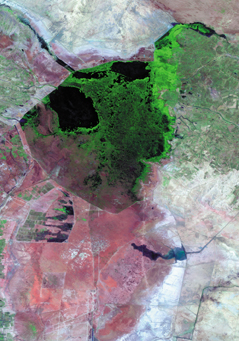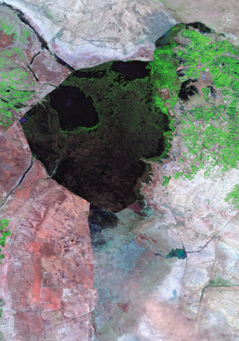
 In
March, a reported 24,000 people from 182 countries attended the third meeting
of the World Water Forum hosted in Kyoto, Shiga and Osaka by the World Water
Council (WWC) and others. Discussions primarily revolved around world wide access
to safe drinking water and decent sanitation facilities, but also addressed
the role of climate and development on freshwater resources.
In
March, a reported 24,000 people from 182 countries attended the third meeting
of the World Water Forum hosted in Kyoto, Shiga and Osaka by the World Water
Council (WWC) and others. Discussions primarily revolved around world wide access
to safe drinking water and decent sanitation facilities, but also addressed
the role of climate and development on freshwater resources.These satellite images show the Hawr Al-Hawizeh/Al-Azim wetland, which crosses Iraq and Iran. The image on the immediate right shows the wetland in 2000 and, next to it on the right, the same wetland in 2002. Darker colors indicate regions with more water. The false-color composite image uses mid-infrared, near-infrared, and green wavelengths (Bands 7, 4 and 2) and was acquired by Landsat 7’s Enhanced Thematic Mapper plus (ETM+). Images courtesy of UNEP/GRID-Sioux Falls and USGS EROS Data Centre.
In the Ministerial Declaration, which took into consideration the final recommendations from the forum’s organizing committee, the ministers and heads of delegation announced they will “further encourage scientific research on predicting and monitoring the global water cycle, including the effect of climate change and develop information systems that will enable the sharing of such valuable data worldwide.”
Earth scientists play a paramount role in mitigating a growing freshwater crisis. “You can’t manage what you don’t understand,” says Craig Schiffries of the National Council for Science and the Environment (NCSE), who attended the forum.
With a vast range of presentations coming from water ministers, heads of state and nongovernmental organizations, the sessions took on an advisory discussion that was far different from the technical sessions scientists are accustomed to attending. “True, there was no R&D, high-tech geeky stuff, but by and large that wasn’t why we were there,” says Ken Lanfear of the U.S. Geological Survey (USGS). “The technology behind the scenes, databases and things like that were not the focus of the meeting. But if you really listened and observed the sessions, you would come out with more of an open mind on what science is doing and what its effects are.”
The United Nations Environment Programme (UNEP), for example, was clear during its presentation that a new regime in Iraq would need to take action on restoring the Mesopotamian marshlands that cross the border between Iraq and Iran, or the wetland would become desert in five years. Subsequently, a geologist and a soil engineer, funded by the Iraq Foundation to begin the restoration project, are now working in conjunction with UNEP. The team plans to establish an office in Baghdad this month and start surveying the hydrology of the region.
In Central Asia, five countries along the drying Aral Sea have struggled for more than 10 years with health and ecosystem damages, says Norio Yamamoto of the Global Infrastructure Fund Research Foundation, based in Tokyo. Yamamoto chaired a session at the forum that recommended installing large-scale systems that cross national borders and monitor water quality and quantity at several key points along the 2,000-kilometer-long rivers Amu Darya and Syr Darya that feed into the sea. “The data collected should be available to all the riparian countries in real time,” Yamamoto concluded in the summary of the session. “The systems would provide information that could be used to formulate comprehensive, rational and efficient approaches to the management of the regional water resources that eventually pour into the Aral Sea.” The session participants also recommended that financial aid to Afghanistan introduce efficient irrigation methods, sustainable agriculture and secondary industry, as the country accounts for an estimated 13 percent of the runoff into the Amu Darya River.
The sharing of data is fundamental to Western policy, but, Lanfear says, unusual in other countries. At the forum, USGS stressed the advantages of data-sharing. For example, the Environmental Protection Agency’s Storage and Retrieval (STORET) program — a repository for water quality, biological, and physical data — and USGS’s National Water Information System (NWIS), both provide their data free online as a public service. “Stream gages and water quality — it’s all free,” Lanfear says. “The business model being that users and elected representatives appreciate the value and support it through appropriations processes. In contrast, most of the rest of the world follows the user-pays model. For example if you’re in London and you want that kind of information you have to pay a fee.” Lanfear added that although the public service model might not always be the best for all circumstances, both NWIS and STORET have shown long-term success.
The International Flood Network (IFNet) was launched during the forum as a source for exchanging global flood information and raising the awareness of floods beyond the regional level. IFNet plans to provide a Global Flood Warning System with the capacity to create precipitation maps all over the world every three hours, according to the forum’s organizing committee. “As a result, flood warnings in the world will be vastly improved, benefiting up to 4.8 billion people,” the committee wrote. As one of the 100 final commitments made during the forum, Japan’s Ministry of Land, Infrastructure and Transport supported the establishment of IFNet.
During the forum, protests erupted over the issue of privatizing water, with environmentalists accusing businesses of excluding poorer communities from services. At the same time, water supply company officials claimed public water supplies couldn’t meet demand. The stance of the Ministerial Declaration was to take the middle ground: “All sources of financing, both public and private, national and international must be mobilized and used in the most efficient and effective way.”
The final statements from the forum’s organizing committee did not designate water as a basic human right, although some had hoped it would — including President Jacques Chirac of France, who had stressed that point during a video address to the forum. Instead, the committee described freshwater as “a precious and finite resource central to sustainable development, economic growth, social stability and poverty alleviation.” Also the organizing committee of the forum agreed to meet the goal the UN Millennium Summit in New York set two years ago: to cut in half the proportion of poor people without secure access to water and sanitation by 2015. Currently, about 1.1 billion people, mostly women, are collecting water from unsafe drinking sources and 2.4 billion people go without adequate sanitation.
Christina Reed

